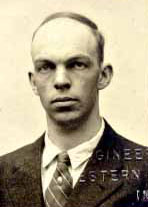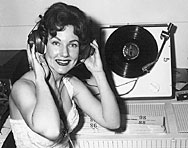1916 - Harvey Fletcher joined the Research Division of Western Electric Engineering Dept to work with Irving Crandall on hearing and speech, was director of acoustic research at Bell Labs 1927-49, built the Western Electric Model 2A hearing aid and a binaural headset in the 1920's, published the widely-read book Speech and Hearing in 1929 that analyzed the characteristics of sound. Fletcher would lead much of the research on binaural, or what later would be called "stereophonic" sound recording, at Bell Labs.
1931 - In December, Harvey Fletcher and Arthur C. Keller of Bell Labs with Leopold Stokowski used improved electrical recording equipment in the Academy of Music in Philadelphia to record and transmit monaural and binarual sound. Also in December, Alan Dower Blumlein filed a patent application in Britain for stereo recording.
1933 - April 27 Stereoscopic sound was transmitted to the National Academy of Sciences and many invited guests at Constitution Hall, Washington. Transmission was over wire lines from the Academy of Music in Philadelphia and three channels were used with microphones respectively at left, center and right of the orchestra stage and loud speakers in similar positions in Constitution Hall. The orchestra in Philadelphia was conducted by Alexander Smallens while Dr. Stokowski in Washington manipulated the controls so as to enhance the music in accordance with his own views.
1934 - Jan. 19 Alan Blumlein recorded Thomas Beecham at the Abbey Road Studio in stereo, conducting Mozart's "Jupiter Symphony" with a vertical-lateral technique using a stylus to vibrated in 2 directions, first recording one channel of sound in a groove laterally and then recording another channel of sound in the same groove vertically.
1940 - Harvey Fletcher and Stokowski made another stereophonic demonstration at Carnegie Hall April 9 and 10, with recorded stereo music from a three-channel system using sound on film with a frequency range of 30 to 15,000 cps and a volume range of 120 decibels. A 4th track was used as a loudness playback control track. The New York Times reported April 10 "Sound Waves 'Rock' Carnegie Hall As Enhanced Music' Is Played" and "The loudest sounds ever created crashed and echoed through venerable Carnegie Hall last night as a specially invited audience listened, spellbound, and at times not a little terrified."
1945 - Decca's early stereo LPs used a Teldec/Neumann Stereo cutter to record one channel lateral and another vertical, each on the opposite wall of a groove; but the dual tracks could not be reproduced with heavy mono pickups on the turntables and record players.
1949 - General Motors asked Magnecord to make a stereo tape recorder to improve spatial analysis of automobile noise. Magnecord modified its PT-6 tape recorder that had been introduced in May 1948 at the National Association of Broadcasters show. This modified recorder was introduced at the 1949 Audio Fair in New York with two record/play heads 1.5 inches apart, each with its own amplifier.
1951 - Emory Cook made the first stereo recordings of railroad trains in the field for the LP titled "Rail Dynamics" demonstrated at the 1951 Audio Fair in New York.
1953 - The Robe had 4-track stereo sound; was the first CinemaScope film and led the release of 33 stereo films in 1953, but stereo failed to transform motion picture soundtracks and would not reappear until 1975 with Dolby optical stereo sound. The Robe used directional sound, footsteps of Roman Legions marching from right to left, thunder and wind and rain of the crucifixion scene. The first time off-screen voices are actually heard off-screen, when voices warn Marcellus of his ship departure to Judea. Only Fox and Todd-AO would record dialogue with directional sound. All other studios provided some music in stereo for magnetic soundtracks, but recorded voices and sound effects in mono.
 |
1954 - Murray Crosby demonstrated FM stereo multiplex system in his Syosset, Long Island, lab to 16 executives of RCA; his demo was the result of a request by Leopold Stokowski to David Sarnoff; this was the first time the executives heard stereo and it led to the issue of RCA prerecorded open-reel stereo tapes; No. 1 tape that sold for $18.95 was "Also Sprach Zarathustra" by Richard Strauss, recorded by the Chicago Symphony Orchestra under Fritz Reiner using 2-track magnetic tape at 30 ips, 2 Neumann M-50 omnidirectinal mics 12 ft. high and placed 24 ft. apart with the orchestra in between.
1954 - Feb. 21, RCA made its first commercial stereo recording of a symphony when Jack Pfieffer and Leslie Chase went to Symphony Hall in Boston to record the "Damnation of Faust" by Berlioz with a RCA RT-11 two-channel tape recorder and two Neuman U-47 mics. This same month, EMI in London made "Stereosonic" recordings at its Abbey Road studio that were announced to the public in April 1955.
1954 - In May, Decca made its first stereo recordings at the Kingsway Hall studio for classical music recording in London with the "Decca tree" designed by Roy Wallace, using 3 directional cardioid-pattern Neuman KM-56 condensor mics suspended eleven feet above and slightly behind the conductor's platform on a cross-bar, pointed 30 degrees down to the orchestra and clustered tightly together to exclude reflected sounds from the sides and rear. The mixed signal was recorded on an Ampex 350-2 recorder at 15 ips.
1957 - Sept. 5 Westrex gave a private demonstration of its 45-45 stereo disc recording system. Shortly after, Haddy demonstrated the Decca V-L system to RCA. The Westrex system was publicly demonstrated at annual convention of the Audio Engineering Society in New York Oct. 11. The Recording Industry Association of America (RIAA) adopted the Westrex system and the "full stereo record" (not compatible with mono records) with stylus tip of 0.7-1.0 mil radius and vertical force of 6 grams as the industry standard on March 25, 1958. High Fidelity components began to appear.
1958 - Oct. 18 the BBC began regular stereo broadcasts Saturday mornings
1960 - The dual bilateral light valve was developed, that allowed each side of an optical motion picture soundtrack to be modulated independently, allowing 2-channel stereo sound. The movie industry adopted stereo optical sound quickly, and it was the movie industry that pushed multichannel sound into home market.
1961 - April 19 FCC ruled in favor of the GE/Zenith stereo FM system rather than Crosby matrix system. Murray G. Crosby had worked for Edwin Armstrong and Crosby held 150 patents and wanted the FCC to adopt his stereo FM system that utilized the matrix principle (that of transmitting the sum signal L+R as the main channel modulation and the difference signal L-R as a subcarrier) rather than suppressed AM subcarrier principle (by Zenith & GE). WEFM in Chicago and WGFM in Schenectady began stereo FM broadcasting June 1.
 |
1962 - 87 FM radio stations existed in 29 states and Canada, including 2 FM stations in New York City; John Koss was starting to promote his idea of individual stereo headphone listening, but few audio components had headphone jacks.
1968 - Sheffield Lab made the first modern direct disc recording, "Lincoln Mayorga and Distinguished Colleagues Volume One." No tape recorder was used and only a limited number of records was manufactured. Only one single point stereo tube mic designed by Sheffield Lab was used.
1970 - Quadraphonic sound used 4-channels, but produced an "antisocial" stereo sound that allowed only one listener to hear it correctly in the stereo seat, or "sweet spot." There was no center channel. Although it failed, the technology had a lasting effect, especially the JVC CD-4 system that recorded 4 discrete channels in the grooves of an LP record by extending the bandwidth to 50 khz. Stereo systems developed better cutting and pressing technology, better pickups with wider bandwidth and reduced tracking distortion.